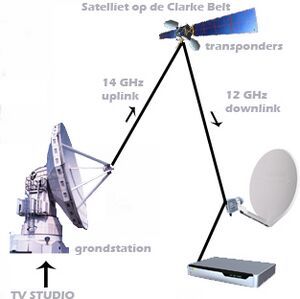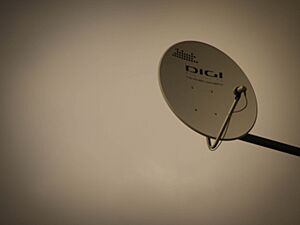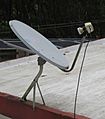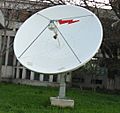Satellite television facts for kids
Satellite television lets you watch TV shows by sending them from a communications satellite orbiting Earth directly to your home. You need a special outdoor dish, often called a satellite dish, to catch these signals. A small device called a low-noise block downconverter (LNB) helps prepare the signal.
After the dish and LNB, a satellite receiver decodes the TV show so you can watch it on your television set. These receivers can be separate boxes or built right into your TV. Satellite TV offers many channels and services. It's often the only TV option in faraway places where regular terrestrial television (broadcast from towers) or cable television isn't available.
Today's satellite TV uses signals from a communications satellite on the Ku band (12–18 GHz). This means you only need a small dish, less than a meter wide. Older systems, called "television receive-only," used weaker analog signals in the C-band (4–8 GHz). They needed much larger dishes, about 2-3 meters wide, which made them more expensive and less common.
Early satellite TV used analog signals. But modern systems use digital signals. Digital signals are much better because they can carry high-definition television (HDTV) and fit more channels into the same space. As of 2018, only a few old analog broadcasts remained, like Star One C2 in Brazil and one channel (C-SPAN) on AMC-11 in the United States.
You need different receivers for analog and digital signals. Some channels are free to watch, while others are encrypted. For encrypted channels, you usually need to subscribe and pay a monthly fee to watch the shows. More and more people are now choosing internet-based streaming television instead of satellite TV.
How Satellite TV Works
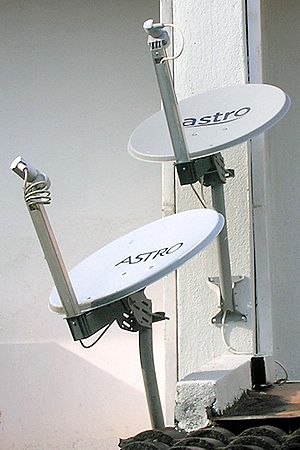


Satellites that broadcast TV usually orbit Earth about 37,000 km (23,000 mi) above the equator. This is called a geostationary orbit. The great thing about this orbit is that the satellite moves at the same speed as Earth spins. So, the satellite always looks like it's in the same spot in the sky. This means your satellite dish can stay pointed in one direction without needing to move. A few systems use a different, highly elliptical orbit called a Molniya orbit.
Satellite television, like other satellite communications, starts at a special place on Earth called an uplink facility. This is where the TV signals are sent up to the satellite.
The uplink dishes are very large, often 9 to 12 meters (30 to 40 feet) wide. Their large size helps them aim very accurately and send a strong signal to the satellite. The uplink dish points to a specific satellite. The signals are sent on a certain frequency so that a transponder on the satellite can receive them.
The transponder then sends the signals back down to Earth on a different frequency. This change in frequency stops the uplink and downlink signals from interfering with each other. These signals usually come back in the 10.7-12.7 GHz range, but some still use the C-band (4–8 GHz) or Ku-band (12–18 GHz). The path from the satellite back to Earth is called the downlink.
The downlink signal from the satellite is very weak because it travels a huge distance. Your parabolic satellite dish collects this weak signal. The dish reflects the signal to a special point called the focal point. At this point, a device called an LNB (low-noise block downconverter) is located.
The LNB converts the high-frequency satellite signals into lower frequencies. In the United States, these lower frequencies are in the 950–2150 MHz range. This makes it easier for the signal to travel from the dish to your receiver box using a cable.
The satellite receiver, or set-top box, then takes these signals. It changes them into the right format for your TV, audio, or other devices. Many receivers can also unscramble or decrypt encrypted signals. This allows you to watch premium channels that you pay for. When a receiver can do this, it's called an integrated receiver/decoder (IRD).
There are five main parts in a satellite TV system:
- The programming source (where the TV shows come from).
- The broadcast center (where signals are sent to the satellite).
- The satellite (in space).
- The satellite dish (at your home).
- The receiver (connected to your TV).
The set-top box lets you pick the channel you want to watch. It filters out that channel from all the signals it receives from the satellite. It then converts the signal to a lower frequency, decrypts it if needed, and changes the radio signal into a video signal for your TV. To decrypt signals, the satellite company must "activate" your receiver box. If you don't pay your bill, the company can "deactivate" your box remotely, and it won't work until reactivated.
Older analog TV signals sent by satellite were often scrambled or unscrambled. They used standards like NTSC, PAL, or SECAM. These analog signals were frequency modulated and then converted into a "baseband" signal. This baseband included the video signal and audio.
Later, TV signals became digital. These digital signals are usually based on open standards like MPEG and DVB-S/DVB-S2 or ISDB-S.
What is a Sun Outage?
A sun outage happens when the sun lines up exactly behind the satellite from your dish's point of view. This occurs for about 10 minutes each day, twice a year, for about two weeks in spring and fall around the equinox. During this time, the sun's strong microwave noise on the same frequencies as the satellite's signals can block your TV reception. It's like the sun is shouting so loudly that you can't hear the satellite anymore!
Images for kids
See also
 In Spanish: Televisión por satélite para niños
In Spanish: Televisión por satélite para niños


